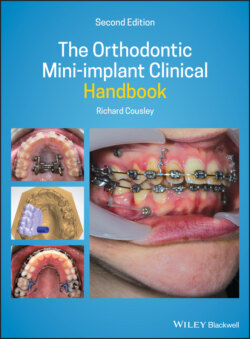Читать книгу The Orthodontic Mini-implant Clinical Handbook - Richard Cousley - Страница 29
1.16 Mini‐implant Migration
ОглавлениеThis depends on the head (and neck) to body ratio, on the degree of bone support (stability), and on the relative force level. In effect, both self‐tapping and self‐drilling mini‐implants may tip and/or translate bodily in the direction of the applied force [66–70]. This is problematic if it causes the mini‐implant head to approximate an adjacent bracket or crown and cause soft tissue impingement or difficulty in utilising the mini‐implant head.
Figure 1.6 (a) Photograph of lower anterior mini‐implants immediately after insertion. (b) Hyperplasia of the loose sulcular mucosa around the right mini‐implant one month after insertion. (c) Effective oral hygiene measures have resolved the hyperplastic tissue problem on the right side eight weeks later, enabling the continued use of this mini‐implant.
Figure 1.7 (a) Hyperplasia of the palatal mucosa covering an overinserted mini‐implant in the palatal alveolar site between the left molars. (b) Normal tissue appearance after simple excision of the hyperplastic tissue and replacement of this mini‐implant. Minor peri‐implant hyperplasia is seen on the right side.
